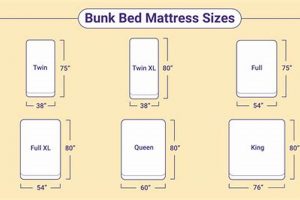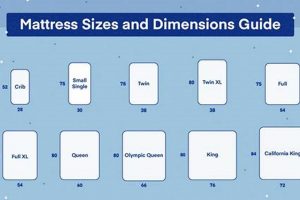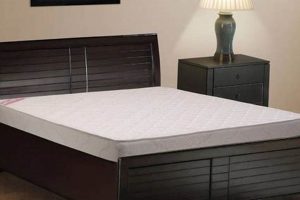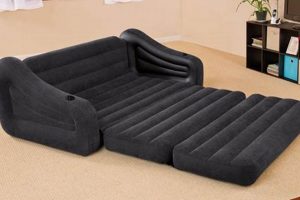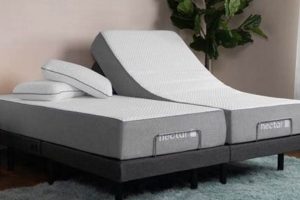Bunk beds typically utilize mattresses that conform to standard dimensions, primarily twin size. These mattresses measure approximately 39 inches wide by 75 inches long. This standardized size allows for compatibility across various bunk bed frame designs and ensures adequate sleeping space for one individual. It’s essential to confirm the specific measurements recommended by the bunk bed manufacturer, as slight variations may exist depending on the design.
Adherence to specified mattress dimensions is crucial for safety and functionality. Using a mattress that is too thick can compromise the safety rail height, increasing the risk of falls from the upper bunk. A mattress that is too thin might not provide adequate support and comfort. The standardized size promotes efficient space utilization, a key benefit in shared bedrooms or smaller living spaces. Historically, bunk beds have been a practical solution for maximizing sleeping arrangements in confined areas, and the consistent mattress size contributes to this efficiency.
The selection of an appropriate mattress involves considering factors beyond just length and width. Mattress thickness, material, and overall support are all critical aspects to evaluate when choosing the right mattress for a bunk bed, ensuring both safety and comfortable sleep.
Bunk Bed Mattress Selection Tips
Selecting the appropriate mattress size for bunk beds is paramount for safety, comfort, and optimal space utilization. Careful consideration of the following tips will aid in making an informed decision.
Tip 1: Adhere to Manufacturer Specifications: Always consult the bunk bed frame’s manufacturer guidelines regarding recommended mattress dimensions and thickness. Failure to comply can compromise safety rail height and structural integrity.
Tip 2: Prioritize Safety Rail Height: Ensure that the selected mattress allows for sufficient safety rail height on the upper bunk. A standard recommendation is at least five inches of rail height above the mattress surface.
Tip 3: Consider Mattress Thickness: Mattress thickness significantly impacts both safety and comfort. Thicker mattresses may reduce safety rail effectiveness, while thinner mattresses may lack adequate support. A balance must be achieved.
Tip 4: Opt for Standard Twin Size: In most cases, bunk beds are designed for standard twin-size mattresses (approximately 39″ x 75″). Deviating from this standard may necessitate custom mattress solutions or pose compatibility issues.
Tip 5: Evaluate Mattress Material: Consider the mattress material based on comfort preferences and potential allergens. Options include innerspring, memory foam, latex, and hybrid models. Assess the support and firmness levels of each material.
Tip 6: Measure Available Space: While twin is standard, confirm measurements. If the bedroom size is small, confirm by measuring. Sometimes the room might require a specific, smaller size than standard.
Selecting the correct size ensures safety and comfort. Correct mattress size prevents injury and maximizes sleep satisfaction. Consulting manufacturer specifications, prioritizing safety rail height, and considering mattress thickness are all crucial steps in the mattress selection process.
Following these tips facilitates a more informed decision, improving the functionality and safety of bunk bed sleeping arrangements.
1. Twin (39" x 75")
The “Twin (39″ x 75″)” mattress dimension constitutes a foundational element in the realm of bunk bed configurations. It dictates the compatibility, safety, and functional parameters within which bunk bed systems operate. Its standardized nature underpins the design and manufacturing processes of both mattresses and bunk bed frames.
- Standardization and Compatibility
The twin size (39″ x 75″) is the de facto standard for bunk bed mattresses. This widespread adoption ensures that mattresses and bed frames from different manufacturers are generally compatible. The standardization simplifies the mattress selection process and reduces the likelihood of mismatched dimensions, enhancing usability.
- Space Optimization in Shared Rooms
In shared bedrooms, particularly those accommodating children or multiple occupants, the twin-size mattress contributes to efficient space utilization. The dimensions are compact enough to allow for multiple sleeping surfaces within a limited area, a primary advantage of bunk bed systems. The 39″ x 75″ footprint minimizes the area occupied by each sleeping space.
- Safety Considerations and Design Limitations
While the twin size provides space efficiency, it also imposes design limitations. Mattress thickness must be carefully considered to ensure adequate safety rail height on the upper bunk. Excessive mattress thickness reduces the protective barrier, increasing the risk of falls. Manufacturers design bunk bed frames with specific mattress thickness parameters in mind to balance comfort and safety.
- Cost-Effectiveness and Availability
The widespread use of the twin-size mattress in bunk beds translates to cost-effectiveness. High production volumes drive down manufacturing costs, resulting in lower prices for consumers. Furthermore, the ubiquity of this size ensures wide availability across various retailers, both online and in brick-and-mortar stores. Replacement and upgrades are easily facilitated by the ample supply.
The twin-size mattress, measuring 39″ x 75″, represents a core element of bunk bed design. Its standardized dimensions promote compatibility and efficiency, while simultaneously imposing design constraints related to safety and mattress thickness. Understanding these interconnected facets provides a comprehensive perspective on selecting the appropriate mattress for a bunk bed system.
2. Thickness limitations
Thickness limitations are a critical factor when considering mattress size for bunk beds. The vertical space constraints inherent in bunk bed designs directly influence the permissible mattress thickness. These limitations are not arbitrary; they are dictated by safety regulations and intended functionality.
- Safety Rail Protrusion
The primary determinant of mattress thickness limitations is the need for adequate safety rail protrusion. Safety rails are designed to prevent occupants of the upper bunk from falling. If a mattress is too thick, it diminishes the effective height of the safety rails, thereby increasing the risk of accidental falls. Regulations often stipulate a minimum distance the safety rail must extend above the mattress surface, directly impacting allowable mattress thickness.
- Ladder or Stairway Access
Matt
ress thickness also affects accessibility to the upper bunk via ladders or stairways. A too-thick mattress can obstruct or reduce the clearance for safe and comfortable climbing. This can create difficulties for users, particularly children, increasing the risk of slips or falls during ascent or descent. Optimal mattress thickness ensures unimpeded access and egress. - Weight Distribution and Frame Integrity
While less direct than safety concerns, excessive mattress thickness can impact weight distribution on the bunk bed frame. Thicker mattresses, especially those constructed from dense materials like memory foam, can concentrate weight in specific areas, potentially straining the frame. Adhering to recommended thickness limits helps maintain structural integrity and prolong the lifespan of the bunk bed.
Therefore, when assessing what size mattress is appropriate for a bunk bed, thickness is an equally important consideration alongside length and width. Ignoring these limitations can compromise safety, accessibility, and the longevity of the bunk bed structure itself.
3. Safety rail height
Safety rail height is intrinsically linked to mattress dimensions in bunk beds. The selection of “what size mattress are bunk beds” directly impacts the effectiveness of the safety rails. The safety rails are designed to prevent falls from the upper bunk. If a mattress is too thick, it reduces the exposed height of the safety rail, diminishing its protective function. A mattress that is too thin, conversely, may not provide adequate comfort and support, but will maximize the safety rail height.
Regulations and manufacturer guidelines typically stipulate a minimum safety rail height above the mattress surface. This height is essential to provide a barrier sufficient to prevent accidental falls during sleep. For example, a bunk bed with a prescribed safety rail height of 14 inches requires a mattress of appropriate thickness to ensure that at least 5 inches of the rail remains above the mattress. Choosing a 10-inch mattress would leave only 4 inches of rail, violating the recommended safety margin. Ignoring this consideration poses a significant safety risk, particularly for children using the upper bunk.
Therefore, ensuring adequate safety rail height through proper mattress selection is paramount. The connection is that one affects the other. The best size mattress is one that is not too thick to reduce safety, but also not too thin to be comfortable. The selection of “what size mattress are bunk beds” should never compromise the intended safety function of the bunk bed design.
4. Weight capacity
Weight capacity is a critical safety parameter directly influenced by the dimensions and materials of a bunk bed mattress. Exceeding the specified weight limit can compromise structural integrity, leading to potential hazards. Mattress selection, guided by the question of “what size mattress are bunk beds,” must account for this often-overlooked factor.
- Distribution of Load
Mattress dimensions affect the distribution of weight across the bunk bed frame. Larger mattresses, while potentially offering more sleeping space, can concentrate weight in specific areas if not adequately supported. The “what size mattress are bunk beds” query should thus also consider the support structure of the frame and the mattress’s ability to distribute weight evenly to avoid localized stress.
- Mattress Material Density
The density of mattress materials significantly influences overall weight. A memory foam mattress, for example, generally weighs more than an innerspring mattress of the same dimensions. Therefore, when considering “what size mattress are bunk beds,” the material composition must be factored into the total weight calculation to ensure it remains within the bunk bed’s specified limit. Failure to do so can place undue strain on the frame.
- Occupant Weight Considerations
The weight capacity encompasses not only the mattress itself but also the weight of the occupant(s). Choosing “what size mattress are bunk beds” requires considering the weight of individuals who will be using the bunk. A standard twin mattress might be appropriate in terms of dimensions, but if intended for heavier individuals, it’s crucial to ensure that both the mattress and the bunk bed frame can safely accommodate the combined weight. This is especially important for adult use or in scenarios where children may share the upper bunk.
- Long-Term Structural Integrity
Consistently exceeding weight limits, even by a small margin, can gradually degrade the structural integrity of the bunk bed over time. Stress fractures, joint weakening, and material fatigue can result from prolonged overloading. Selecting “what size mattress are bunk beds,” combined with adhering to weight capacity guidelines, ensures the long-term safety and stability of the bunk bed frame, protecting users from potential collapses or failures.
Therefore, “what size mattress are bunk beds” extends beyond simple dimensional considerations. Adherence to weight restrictions, determined by mattress dimensions and material composition, is critical for maintaining safety and preventing structural compromise. A comprehensive approach includes evaluating weight distribution, mattress density, occupant weight, and the long-term effects of exceeding weight limits.
5. Frame compatibility
Frame compatibility constitutes a fundamental consideration when addressing “what size mattress are bunk beds.” The intended mattress must physically and functionally integrate with the existing bed frame to ensure safety, stability, and optimal utilization of space. Discrepancies between mattress dimensions and frame design can lead to hazardous conditions and a compromised sleeping experience.
- Dimensional Alignment
Dimensional alignment is paramount. The mattress must fit snugly within the frame’s perimeter. A mattress too small will shift, creating gaps and potential entrapment hazards. A mattress too large may not fit within the frame or may compromise the structural integrity of the bed. Accurate measurements of the frame’s interior dimensions are critical for determining what size mattress is required.
- Support Structure Integration
The mattress must be adequately supported by the frame’s structure. This typically involves slats, a mesh base, or a solid platform. Insufficient support can cause mattress sagging, uneven weight distribution, and premature wear. The design of the support structure should correspond to the mattress type and weight to ensure proper load-bearing capacity. The number of slats, their spacing, and the material they are made of all contribute to this factor. Slats must be compatible in size and strength for proper weight distribution.
- Safety Feature Accommodation
Frame compatibility extends to the accommodation of safety features, particularly safety rails on the upper bunk. The mattress thickness must be considered in relation to the height of the safety rails to ensure adequate protection agai
nst falls. A mattress that is too thick reduces the effective height of the safety rails, diminishing their protective function. The interplay between mattress thickness and safety rail height is a critical safety consideration. - Accessibility and Ease of Use
The combined height of the frame and mattress should allow for easy access to the upper bunk via a ladder or stairs. A mattress that is too thick or too thin can make climbing difficult and potentially hazardous. Similarly, the overall configuration should allow for easy making of the bed and changing of linens. Design for intended use case is an often overlooked element.
In summation, the determination of “what size mattress are bunk beds” must be inextricably linked to a comprehensive assessment of frame compatibility. This includes ensuring dimensional alignment, support structure integration, safety feature accommodation, and accessibility. Failure to consider these factors can compromise safety, stability, and the overall functionality of the bunk bed system.
6. Support system
The support system of a mattress, in relation to “what size mattress are bunk beds,” is a critical determinant of both comfort and structural integrity. It dictates how weight is distributed across the frame and influences the mattress’s overall lifespan and suitability for bunk bed use.
- Slat Spacing and Material
The spacing between slats and the material from which they are constructed directly impacts the support offered to a mattress. Wider gaps between slats can cause a mattress to sag, leading to uneven weight distribution and potential discomfort. Slats made of weaker materials, such as low-grade wood, may bend or break under consistent pressure, compromising the mattress’s support. The correct slat spacing and material are key factors in determining the appropriate mattress for the intended weight and use.
- Platform Base Considerations
A solid platform base provides uniform support across the entire mattress surface. This can be particularly beneficial for memory foam mattresses, which tend to conform to the shape of the supporting surface. However, solid platforms can also restrict airflow, potentially leading to moisture accumulation and reduced mattress lifespan. Decisions regarding “what size mattress are bunk beds” should consider whether the frame utilizes slats or a platform base to optimize comfort and mattress longevity.
- Edge Support Enhancement
Edge support refers to the reinforcement along the perimeter of a mattress. Stronger edge support prevents the edges from collapsing under pressure, providing a more stable sleeping surface and facilitating easier sitting and getting in and out of bed. Bunk beds, often used in confined spaces, benefit from enhanced edge support to maximize usable sleeping area and minimize roll-off risks. Reinforcement along the perimeter stabilizes the bed and reduces degradation.
- Coil Systems and Weight Distribution
For innerspring mattresses, the coil system is a primary component of the support system. Different coil designs, such as individually wrapped coils or interconnected coils, offer varying levels of support and motion isolation. Individually wrapped coils conform to the body’s contours, reducing motion transfer between sleepers, while interconnected coils provide a more uniform support surface. The density and arrangement of coils will influence the mattresses weight distribution properties.
The integration of these support system components significantly influences the suitability of a mattress for bunk bed applications. A well-designed support system ensures proper weight distribution, enhances comfort, and prolongs mattress lifespan, ultimately contributing to a safer and more restful sleep experience within the constraints of the bunk bed environment.
Frequently Asked Questions
The following questions address common concerns and provide definitive information regarding mattress dimensions for bunk beds. Precise adherence to recommended specifications is paramount for safety and functionality.
Question 1: Are all bunk beds designed for the same mattress size?
No, not all bunk beds accommodate the exact same mattress size, although most are designed for a standard twin (39″ x 75″). Variations can occur depending on the manufacturer and design of the bed. Always consult the manufacturer’s specifications to determine the appropriate mattress dimensions for a particular bunk bed frame.
Question 2: Can a full-size mattress be used on a bunk bed?
Typically, no. Full-size mattresses are wider (54″ x 75″) than twin-size mattresses and generally incompatible with standard bunk bed frames. Attempting to use a full-size mattress on a bunk bed designed for a twin mattress can compromise safety and structural integrity.
Question 3: How important is mattress thickness for bunk beds?
Mattress thickness is critically important. Excessive thickness can reduce the effective height of the safety rails, increasing the risk of falls from the upper bunk. Manufacturers often specify a maximum recommended mattress thickness to ensure adequate safety rail protection.
Question 4: What happens if the recommended mattress thickness is exceeded?
Exceeding the recommended mattress thickness can compromise safety and potentially void the bunk bed’s warranty. The reduced safety rail height increases the risk of falls, and the added weight can place undue stress on the bed frame. It is strongly advised to adhere to manufacturer’s specifications.
Question 5: Do mattress weight limits apply to bunk beds?
Yes, mattress weight limits are a crucial safety consideration. Bunk beds have a specified maximum weight capacity for each bunk, which includes the mattress and the occupant. Exceeding this weight limit can compromise the structural integrity of the bed, leading to potential collapse or failure.
Question 6: Can any type of mattress (innerspring, memory foam, etc.) be used on a bunk bed?
While various mattress types can be used on bunk beds, it’s important to ensure they meet the specified dimensions and weight limits. Heavier mattresses, such as some memory foam models, may exceed the bed’s weight capacity. The support system of the mattress should also be compatible with the bunk bed frame (slats, platform, etc.).
Understanding the precise dimensional requirements, weight limits, and thickness restrictions is paramount for ensuring the safety and functionality of bunk beds. Always consult the manufacturer’s guidelines and prioritize safety when selecting a mattress.
This concludes the frequently asked questions regarding mattress dimensions for bunk beds. The subsequent section will address cleaning and maintenance procedures to prolong the lifespan of your bunk bed mattress.
Conclusion
The exploration of “what size mattress are bunk beds” reveals a critical intersection of safety, comfort, and space efficiency. Standard twin size mattresses (39″ x 75″) are prevalent, but strict adherence to manufacturer-specified dimensions and thickness limitations is paramount. Weight capacities, support system integration, and frame compatibility significantly impact the overall suitability of a mattress for bunk bed use.
The diligent application of these principles is not merely a matter of preference, but a responsibility. Prioritizing these considera
tions ensures the long-term safety, structural integrity, and functional longevity of bunk bed systems. A thorough understanding of these factors facilitates responsible decision-making, promoting secure and restful sleeping environments.


